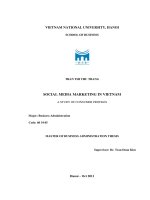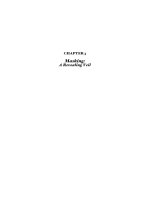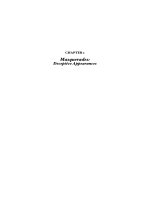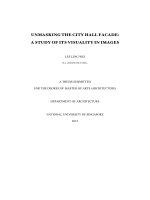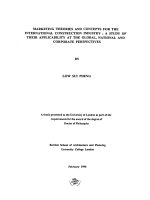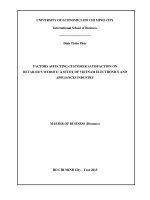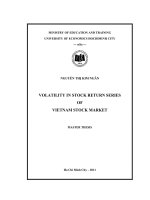The idiosyncratic momentum anomaly: A study of Vietnam stock market
Bạn đang xem bản rút gọn của tài liệu. Xem và tải ngay bản đầy đủ của tài liệu tại đây (298.46 KB, 5 trang )
ISSN 1859-1531 - THE UNIVERSITY OF DANANG - JOURNAL OF SCIENCE AND TECHNOLOGY, VOL. 20, NO. 12.1, 2022
103
THE IDIOSYNCRATIC MOMENTUM ANOMALY:
A STUDY OF VIETNAM STOCK MARKET
Hoang Van Hai1*, Tran Thi Tam Chau2, Pham Van Son1
1
The University of Danang - University of Economics
2
Danang Architecture University, Viet Nam
* Corresponding author:
(Received: September 26, 2022; Accepted: December 05, 2022)
Abstract - This paper examines the relationship between
idiosyncratic momentum and future returns in the Vietnam
stock market. This study utilizes the Vietnam Stock market
from the DataStream database, containing listed and delisted
stocks from July 2010 to June 2021. Based on the portfolio-level
analysis and Fama-Macbeth regressions results, we find that
there is a positive and significant relationship between
idiosyncratic momentum and future returns. Moreover, these
results are robust after controlling for several well-known
variables, such as market beta, firm size, book-to-market, and
momentum. We also find that the predicted power of
idiosyncratic momentum cannot be explained by crash risk,
however, idiosyncratic momentum is driven by market states.
Key words - Idiosyncratic momentum; Price momentum;
Anomaly; Crash risk; Vietnam stock market
1. Introduction
Among anomalies, price momentum effect is widely
document in the asset pricing study. According to
Jegadeesh & Titman [4], the effect of price momentum can
be defined as the stocks that have performed well in the
past and are likely to outperform in the future. Many
studies confirm the positive relationship between price
momentum and future return in the international market, as
well as in different asset classes [5, 6]. Recently, Blitz,
Hanauer, & Vidojevic [1, 2] have introduced the
idiosyncratic momentum (IMOM) as the same former
principle of price momentum as in Jegadeesh & Titman [4].
According to Blitz, Hanauer and Vidojevic [1, 2],
idiosyncratic momentum is estimated using the last 12month residual returns relative to Fama and French threefactors model. Especially, this anomaly is priced in the
cross-sectional of stock returns in the market where the
effect of price momentum does not exist such as Japanese
stock market [7], Chinese stock market [8], and the Asian
markets such as Hong Kong, Singapore, Taiwan and
Thailand [9].
Motivates by previous study, in this research, we
investigate the predicted power of idiosyncratic
momentum effect in the Vietnam stock market. In the
other words, this research paper aims to provide out-ofsample evidence about the idiosyncratic momentum
effect from the emerging stock market, such as Vietnam
stock market. To the best of our knowledge, there are no
relevant studies on Vietnam stock market. Following
Blitz, Hanauer and Vidojevic [1, 2], Qi Lin [8], the core
objectives of this research are that: (i) Whether IMOM is
priced in the Vietnam stock market; (ii) Whether IMOM
subsumes by other common variables, as well as price
momentum; (iii) Whether IMOM can be driven by crash
risk [10], and market states [11]. To test these hypotheses,
we perform univariate portfolio analysis and FamaMacBeth [3] cross-sectional regressions by using a
sample of non-financial firms listed on the Hochiminh
Stock Exchange (HOSE) and Hanoi Stock Exchange
(HNX) from July 2010 to June 2021.
To achieve our research goals, we first use the portfolio
analysis method, which is employed to investigate the
cross-sectional relations between IMOM and future return.
This method is useful for us to understand variations in the
characteristics of stock across different portfolios.
However, portfolio analysis is a difficult setting in which
to control for multiple effects or factors simultaneously.
Therefore, we next evaluate the relationship between
IMOM and future returns by using Fama and Macbeth [3]
cross-sectional regressions. Unlike portfolio analysis, FM
regression analysis allows us to control for a large set of
other variables when examining the relationship of IMOM
and future return.
We find that the idiosyncratic momentum effect is
positively and statistically significant related to
predicting future return in Vietnam stock market.
Specifically, this study investigates the relationship
between IMOM and future return based on the monthly
return in Table 1. The IMOM effect is statistically and
economically significant, with a hedge portfolio taking
long (short) positions in high (low) IMOM stocks
generating excess returns over 0.79% per month (9.48%
annually). The difference between two portfolios is about
5.17% per year. Comparing to the average risk premium
of international the stock markets of 5.9% based on
Dimson, Marsh and Staunton [12], the 5.17% IMOM
effect is economically significant.
Furthermore, we find that this IMOM anomaly cannot
be explained by the crash risk as in [10]. However, our
result shows that IMOM can be driven by market states.
Particularly, IMOM return associated with Up market can
predict positively and significantly at 1% future return.
Thus, our study contributes to the literature is threefold.
First, we are the first study to determine the magnitude of
IMOM anomaly that was recently discovered in the
international market such as US, Japan, China but hasn’t
yet been documented in the Vietnam stock market. Second,
we analyze the incremental predicted power for IMOM
after controlling for Fama & French's [13] three-factor
104
Hoang Van Hai, Tran Thi Tam Chau, Pham Van Son
model, and Fama and French's [14] five-factor model.
Third, we also find that the IMOM effect is driven by
market status. Our finding is in line with previous studies
on other in Japanese [7], China [8], Hong Kong, Singapore,
Taiwan, and Thailand [9].
The finding of this study provides the following
practical implications. First, this research topic has
attracted special attention from domestic and international
investors due to the rapid internationalization of Vietnam's
stock market and the attractive characteristics of the
idiosyncratic momentum profitability, which could create
interesting opportunities for investors. Second, with the
economic significance of the IMOM anomalies, the meanvariance optimizing investors should employ the
idiosyncratic momentum factor in their investment
strategy, next to traditional factors such as the market, size,
and value in the Vietnam stock market.
2. Data and variable constructions
2.1. Data
The data was primarily obtained from the DataStream
database including the daily, monthly data, and
accounting data. Following Jegadeesh & Titman [4], in
order to maximize the economic and practical
significance of our results, we include the following
filters on our sample of stocks. First, we exclude all
stocks with an (unadjusted) priceless than 5000 VND,
firms with a negative book value of equity, and firms in
the financial sector. In addition, we exclude all stocks that
traded fewer than 15 trading days during month t-1.
Finally, we exclude any stock in our sample for less than
12 months at the time of portfolio formation. Our sample
includes all listed and delisted stocks from July 2010 to
June 2021. The typical stock in our sample has an
approximately 139-month long time series.
2.2. Variable Constructions
We estimate idiosyncratic momentum (IMOM) variable
in three steps following Blitz, Hanauer and Vidojevic [1, 2].
First, the monthly residual returns (εi,t ) is estimated relative
to Fama & French's [13] three-factor over the period of 36
months from t-36 to t-1, as in Equation (1).
R i,t − R f,t = αi + β1 RMRFt + β2 SMBt + β3 HMLt + εi,t (1)
where R i,t is stock i’s return on month t, R f,t is the risk-free
rate on month t by using the one-month interbank offer
rate. RMRF, SMB, HML are the market, size, value factors
following Fama & French [13]. We require at least 36month window to estimate the monthly IMOM.
Secondly, we estimate the monthly residual returns as
in Equation (2):
ei,t = R i,t − R f,t − α
̂i,t + β̂1 RMRFt − β̂2 SMBt + β̂3 HMLt (2)
Finally, IMOM is defined as the monthly prior (2-12)
residual-adjusted mean residual return as in Equation (3)
IMOMi,t =
∑t-2
t-12 ei,t
√∑t-2
i
t-12 (ei,t - e̅)
(3)
For other controlling variables, we include a set of
standard controls variables: market beta, size and book-tomarket ratio following Fama & French [13], momentum
returns (the cumulative return over months t-12 to t-2),
Following Fama & French [14], Operating profitability
(OP) is annual revenues minus cost of goods sold, interest
expense, and selling, general, and administrative expenses
divided by book equity for the last fiscal year end in t-1;
Investment (INV) is the percentage change in firm’s total
assets from year t-2 and t-1 divided by t-2 total assets;
These twos variables are calculated in December of each
year and assigned to all months in the calendar year starting
the following July through June. To ensure that we only
use the information available to the investor at the time of
trading, we match accounting data from year-end T − 1
with monthly returns from July of year T to June of year
T + 1 as in Fama & French [14].
3. Result
3.1. Univariate analysis of anomalies and stock returns
In this part, we examine the predicted power of IMOM
using a portfolio analysis and a cross-sectional test. Based
on these tests, we can examine that whether IMOM is
subsumed by other common factors [1, 2, 13]. We first
present the portfolio analysis results in Table 1, and then
the Fama and Macbeth [3] cross-sectional test in Table 2.
Table 1 shows average monthly excess returns relative
to risk-free rate (EXRET), volatility (VOL), Sharpe ratio
(SHA), risk-adjusted return of market model (CAPM
alpha), risk-adjusted return of Fama-French’s three-factor
model (FF3 alpha), risk-adjusted return of Fama-French’s
five-factor model (FF5 alpha) for quintile portfolio using
equal-weighted. The performance of zero-cost portfolio,
which is the difference between the highest portfolio (H)
and the lowest portfolio (L), is presented in the H-L row of
the table along with associated t-statistics, adjusted
following Newey & West [14] using five lags. We also
provide the GRS test which represents the F-test statistic of
Gibbons [15] and p(GRS) is the p-value for GRS F-test.
Table 1. Performance of portfolios sorted on idiosyncratic
momentum
EXRET
L
0.0013
(0.35)
VOL
SHA
0.1046 0.3989
Alpha
CAPM
Alpha
3FM
Alpha
5FM
0.0009
(0.24)
-0.0006
(-0.18)
0.0020
(0.61)
2
0.0075**
0.0072**
0.1029 0.4090
(2.21)
(2.07)
0.0060*
(1.75)
0.0057**
(2.46)
3
0.0079**
0.0074**
0.1023 0.5578
(2.46)
(2.28)
0.0060*
(1.84)
0.0068**
(2.56)
0.0065
(0.74)
0.0070*
(1.70)
0.0072*
(1.76)
0.0093**
(2.38)
4
H
H-L
GRS
(p-val)
0.0086
(1.24)
0.0995 0.6062
0.0074
(1.13)
0.0092**
0.0086**
0.0987 0.7164
(2.20)
(2.04)
0.0079***
0.0077*** 0.0078*** 0.0073***
0.0633 0.3175
(2.99)
(3.00)
(2.92)
(2.62)
6.7321
(0)
7.6952
(0)
6.4812
(0)
We show the equal-weighted (EW) excess returns of decile
portfolios sorted on idiosyncratic momentum (IMOM). We also
present the excess return, volatility, Sharpe ratio, CAPM alpha,
FF3 alpha, FF5 alpha. * Significant at the 10% level;
** Significant at the 5% level; *** Significant at the 1% level.
ISSN 1859-1531 - THE UNIVERSITY OF DANANG - JOURNAL OF SCIENCE AND TECHNOLOGY, VOL. 20, NO. 12.1, 2022
In Table 1, we can see that excess returns (EXRET),
Sharpe ratios (SHA) increases from the lowest portfolio
to the highest portfolio. For example, the average
EXRET (SHA) value of IMOM increases monotonically
from 0.0013 for the lowest of IMOM to 0.0092 for
stocks in the highest IMOM. We also observe this
phenomenon in the CAPM alpha, FF3 alpha, and FF5 alpha
portfolios.
Focusing on the relation between IMOM and future
stock returns, the results indicate a strong positive and
statistical significantly relation between IMOM and
expected stock returns in the Vietnam stock market.
Particularly, the average H-L EXRET difference between
the return of the high-IMOM (quintile 5) and low-IMOM
(quintile 1) portfolios is 0.0079 with a t-statistic of 2.99.
The difference portfolio’s abnormal returns of 0.0077 per
month (t-statistic = 3.00), 0.0078 per month (t-statistic =
2.92), and 0.0073 per month (t-statistic = 2.62) relative to
the CAPM, FF3, and FF5 risk models, respectively, are
positive and statistically significant.
With the GRS test results in the last row of Table 1, it
can be seen that all GRS test of the CAPM, FF3, and FF5
factor model are 6.7321, 7.6952, and 6.4812, respectively.
These results indicate that CAPM, FF3, FF5 factor model
cannot explain the IMOM. In sum, the result of the relation
between momentum and future stock returns with
univariate portfolio analyses is positive and significant at
the conventional level.
So far, we have already observed the pricing of
idiosyncratic momentum in the Vietnam stock market by
using the single portfolio sort method. However, as Fama
& French [17] point out, portfolio tests are limited by the
number of control variables at one time. Therefore, as a
robustness test, we next perform Fama-Macbeth's crosssectional regressions which are necessary to control the
large set of potential covariates. In fact, by doing this test
we can examine the IMOM effect after controlling several
common variables such as price momentum (MOM)
following Jegadeesh & Titman [4]; market beta (BETA),
firm size (SIZE), and Book to market ratio (BM)
following Fama & French [13]; Operation profit (OP),
and Investment (INV) following Blitz, Hanauer and
Vidojevic [2].
In Table 2, we show the results in the cross-sectional
regressions that are similar to Fama & Macbeth [3].
In particular, each month, we perform the following
Fama - MacBeth regressions with different firm
characteristics included as control variables following
Equation (4):
Ri,t+1 = α0 + β1 IMOMi,t +βX Xi,n,t + ϵi,t+1
n
(4)
where Ri,t+1 is the realized return on stock i in month t+1.
Xi,n,t is the set of control variables, including: Momentum
(MOM), market beta (BETA), firm size (SIZE), book-tomarket (BM), Operation profit (OP), and Investment
(INV). We report the average coefficients for each
anomaly and the Newey-West t-statistics (with a lag of 5)
from the Fama-MacBeth regressions in Table 2.
105
Table 2. Fama-Macbeth cross-sectional regressions
IMOM
Model 1
Model 2
0.0022***
(2.59)
0.0028***
(3.16)
Model 3
Model 4
0.0029***
(3.26)
MOM
-0.0027
(-0.85)
-0.0002
(-0.07)
-0.0030
(-0.83)
BETA
-0.0042
(-1.26)
-0.0041
(-1.23)
-0.0040
(-1.23)
SIZE
0.0012
(0.75)
0.0014
(0.93)
0.0012
(0.81)
BM
0.0038
(0.92)
0.0047
(1.17)
0.0040
(0.98)
OP
0.0506
(0.37)
0.0504
(0.37)
INV
0.0019
(0.64)
0.0023
(0.79)
0.0371
0.0392
Adj-R2
0.0028
0.0323
We provide the estimated coefficient and t-statistics from the
cross-sectional regressions of individual stock excess returns, are
presented in the following table. We use the Fama & MacBeth [3]
procedure to estimate the cross-sectional models and average the
time-series of estimated regression coefficients. The penny stocks
(price ≤ 5000 VND) are excluded from our sample data.
We report the Newey and West [14] adjust t-statistic (with a lag
of 5) are reported in parentheses. * Significant at the 10% level;
** Significant at the 5% level; *** Significant at the 1% level.
In Table 2, we report the time-series averages of the
cross-sectional regression coefficients, along with tstatistics (in parentheses), adjusted following Newey &
West [14] using five lags. All independent variables are
winsorized at the 0.5% level on a monthly basis. The
results in all of the Model indicate a strongly positive
relationship between IMOM and future stock returns after
controlling for the effects of MOM, BETA, ME, BM, OP,
and INV since, regardless of the specification, the average
coefficient on IMOM is positive and statistically
significant.
Specifically, in Model 1, when IMOM is the only
independent variable in the regression, the average
coefficient is 0.0022 with a t-statistic value of 2.59. In
Model 4, when we add all the control variables, the
average coefficient of IMOM is 0.0029 with a t-statistic
value of 3.26. Thus, controlling for the effects of the other
predictors of stock returns appears to have very little
effect on the relation between IMOM and future stock
returns.
In sum, from Table 1 and Table 2, we can conclude that
there is an evidence of the relationship between IMOM and
future return in the Vietnam stock market. This result is
consistent with the finding of Blitz, Hanauer and Vidojevic
[2] in the international stock market.
3.2. Momentum crashes
Following Daniel & Moskowitz [10], Blitz, Hanauer and
Vidojevic [2], we conduct the regression as in Equation (5):
Ri,t = α0 + αB IB,t + [β0 + IB,t (βB + IU,t βB,U )] ∙ (Rmkt - Rf,t ) + ϵi,t (5)
where IB,t and IU,t are dummies indicating whether the past
106
Hoang Van Hai, Tran Thi Tam Chau, Pham Van Son
cumulative twelve-month return of the market is negative
IB,t and whether the subsequent month is non-negative IU,t .
βB indicates whether the market beta differs after past bear
markets, while βB,U indicates the extent to which the
subsequent up- and down-market betas differ after such
market. The results are presented in Table 3.
Table 3. Momentum crashes
L
α0
αβ
β0
2
3
4
H
H-L
-0.0234*** -0.0105** -0.0071 -0.0474** -0.0259***0.0025***
(-4.44)
(-2.46)
(-1.56)
(1.97)
(6.86)
(6.59)
-0.0543
(-1.64)
-0.0145
(-0.88)
-0.0089
(-0.70)
-0.0051
(0.49)
-0.0118
(-0.23)
0.0425*
(1.78)
0.0588*** 0.0706*** 0.0696*** 0.0598*** 0.0680*** 0.0092
(4.14)
(8.13)
(9.41)
(10.49)
(9.44)
(1.07)
βB
0.0555
(1.63)
βB,U
-0.0087
(-0.02)
0.0395** 0.0359** 0.0290** 0.0311* -0.0244**
(1.04)
(2.30)
(2.24)
(1.79)
(-1.98)
-0.0285
(-0.93)
-0.0029
(-1.22)
0.0217
(-1.20)
0.0289** -0.0376***
(-2.20)
(-2.69)
This table presents these results of conditional regressions of the
idiosyncratic momentum long-short (quintile) portfolios
following Equation 5. The Newey & West [14] adjusting
t-statistic (with a lag of 5) are reported in parentheses.
* Significant at the 10% level; ** Significant at the 5% level;
*** Significant at the 1% level.
We find that the coefficient of market beta (βB ) is
negative (-0.0244) and statistically significant (t-statistics
=-1.98). It means that the difference in the market beta
following bull and bear market is statistically significant.
We also find that the βB,U , which is defined as the
subsequent up- and down-market betas differ after such
market, is negative (-0.0376) and significant at the
conventional level. Therefore, this result suggest that
IMOM cannot explained by the crash risk. This results is
in line with the previous study in the developed market [2],
as well as emerging market [8].
3.3. Idiosyncratic momentum and market states
In this section, we examine the predicted power of the
IMOM under the conditions of the market following
Cooper, Gutierrez and Hameed [11]. Specifically, Up
market is defined as the periods with positive 36-month
market returns, while Down market is defined as the
periods with negative 36-month market returns. In each
month, we sort all stocks into quintiles equal-weighted
portfolios based on the IMOM return following Up and
Down market. Then, we estimate the mean monthly profits
and associated t-statistics of the zero-investment portfolios
of the IMOM portfolios. These results are presented in
Table 4.
Table 4. Market states
Mean
t-statics
Up market
Down market
Up-Down
0.0122***
0.0011
0.0111
(3.29)
(0.15)
(0.10)
This table presents the mean monthly profits and associated
t-statistics of the zero-investment portfolios of the IMOM portfolios.
The Newey & West [14] adjusting t-statistic (with a lag of 5) are
reported in parentheses. * Significant at the 10% level;
** Significant at the 5% level; *** Significant at the 1% level.
From Table 4 results, we can see that the IMOM
returns is positive (0.0122) and significant at 1% level in
the UP market, while the IMOM returns is positive
(0.0011) and insignificant (t-statistics = 0.15) in the
DOWN market. The difference between UP and DOWN
market is positive (0.0111) and insignificant (t-statistics
= 0.10). This result suggest that the state of the market is
critically important to the profitability of IMOM
strategies. The finding that IMOM is driven by the state
of the market seems related to the recently evidence from
previous study such as the findings of Blitz, Hanauer and
Vidojevic [2] in the US market. In fact, our finding is in
line with the finding of Blitz, Hanauer and Vidojevic [2],
the IMOM returns are significantly positive in Up market
status and insignificantly positive in Down market status,
as well as the difference between Up and Down market
status is statistically insignificant.
4. Conclusions
In this study, we have demonstrated that there is a
strongly positive cross-sectional relation between
idiosyncratic momentum, measured as the return of
stocks during the period covering months t − 36 through
t – 1 using the Fama and French (1993) three-factor
model, and future return in the Vietnam stock market. The
empirical results indicate that, comparing to conventional
momentum, idiosyncratic momentum can generate
superior return. We also can see that the idiosyncratic
momentum is not subsumed by the crash risk. However,
the idiosyncratic momentum strategy is substantially
affected by market dynamics, where if the return in the
month following a down or up is taken into account. Our
findings delivers a useful out-of-sample test on the
pervasiveness of the idiosyncratic momentum effect
across markets. Overall our study contributes to the
literature on the cross-section of stock returns in
emerging markets by providing evidence of the IMOM
anomalies effect.
Acknowledgements:
We thank the editor and anonymous referees for
comments and suggestions.
This research is funded by Funds for Science and
Technology Development of the University of Danang
under project number B2020-DN04-37.
REFERENCE
[1] Blitz, D., Huij, J., & Martens, M., “Residual momentum”, Journal
of Empirical Finance, 18(3), 2011, 506–21.
[2] Blitz, D., Hanauer, M.X., & Vidojevic, M., “The idiosyncratic
momentum anomaly”, International Review of Economics &
Finance, 69(C), 2020, 932-957.
[3] Fama, E. F., & MacBeth, J. D, “Risk, return and equilibrium:
Empirical tests”, Journal of Political Economy, 81(3), 1973,
607–636.
[4] Jegadeesh, N., & Titman, S., “Returns to buying winners and selling
losers: Implications for stock market efficiency”, The Journal of
Finance, 48(1), 1993, 65-91
[5] Asness, C.S., Moskowitz, T.J. & Pedersen, L.H., “Value and
momentum everywhere”, The journal of finance, 68(3), 2013,
929-985.
ISSN 1859-1531 - THE UNIVERSITY OF DANANG - JOURNAL OF SCIENCE AND TECHNOLOGY, VOL. 20, NO. 12.1, 2022
[6] Jostova, G., Nikolova, S., Philipov, A., & Stahel, C. W.,
“Momentum in Corporate Bond Returns”, The Review of Financial
Studies, 26(7), 2013, 1649–1693.
[7] Chang, R.P., Ko, K.-C., Nakano, S., & Rhee, S.G., “Residual
momentum in Japan”, Journal of Empirical Finance, 45(C), 2018,
283-299.
[8] Qi Lin, “Residual Momentum and the Cross-Section of Stock
Returns: Chinese Evidence”, Finance Research Letters, 29, 2018,
206-215.
[9] Chiao, C.S., Hsiao, Y.J., Chen, J.C., & An, N.M., “Residual
momentum versus price momentum: Evidence from four Asian
markets”, Asia-Pacific Journal of Accounting & Economics, 27(6),
2018, 717-726.
[10] Daniel, K., & Moskowitz, T. J., “Momentum crashes”, Journal of
Financial Economics, 122(2), 2016, 221–247.
[11] Cooper, M.J., Gutierrez, R.C. & Hameed, A., “Market states and
momentum”, The Journal of Finance, 59(3), 2004, 1345-1365.
[12] Dimson, E., P. Marsh, & Staunton, M., “Equity Premia Around the
World”,
2011,
Available
at
SSRN:
/>[13] Fama, E. F., & French, K. R., “Common risk factors in the returns
on stocks and bonds”, Journal of Financial Economics, 33(1), 1993,
3–56.
[14] Fama, E. F., & French, K. R., “A five-factor asset pricing model”,
Journal of Financial Economics, 116(1), 2015, 1-22.
[15] Newey, W., & West, K, “A simple, positive semi-definite,
heteroscedasticity and autocorrelation consistent covariance
matrix”, Econometrica, 55(3), 1987, 703-708.
[16] Gibbons, M.R., Ross, S.A. & Shanken, J., “A test of the efficiency
107
of a given portfolio”, Econometrica, 57(5), 1989, 1121-1152.
[17] Fama, E. F., & French, K. R., “Dissecting Anomalies”, Journal of
Finance, 63(4), 2008, 1653-1678.
APPENDIX A: SUMMARY STATISTIC
The table shows summary descriptive statistics for the variables employed
in this paper, as follows. IMOM is idiosyncratic momentum. BETA is the
firm beta. SIZE is the log firm market capitalization. BM is the book-tomarket ratio. MOM is the cumulative return from the start of month t-7 to
the end of month t-2. OP is Operating profitability. INV is Investment.
Summary statistics include the average value and standard deviation of
each variable in the first two rows and the correlations between all
variables in the remaining rows.
MOM
OP
INV
MEAN
IMOM BETA
0.003
0.787
12.013 13.907
0.041
0.128
0.141
STD
0.991
0.902
1.791
0.357
4.262
0.470
IMOM
SIZE
BM
0.690
1
BETA
0.007
1
SIZE
-0.062
0.069
1
BM
0.077
0.008
-0.530
1
MOM
0.325
-0.006
0.028
-0.072
1
OP
-0.006
-0.017
-0.054
-0.052
0.014
1
INV
-0.038
0.024
0.166
-0.154
0.000
0.013
1
